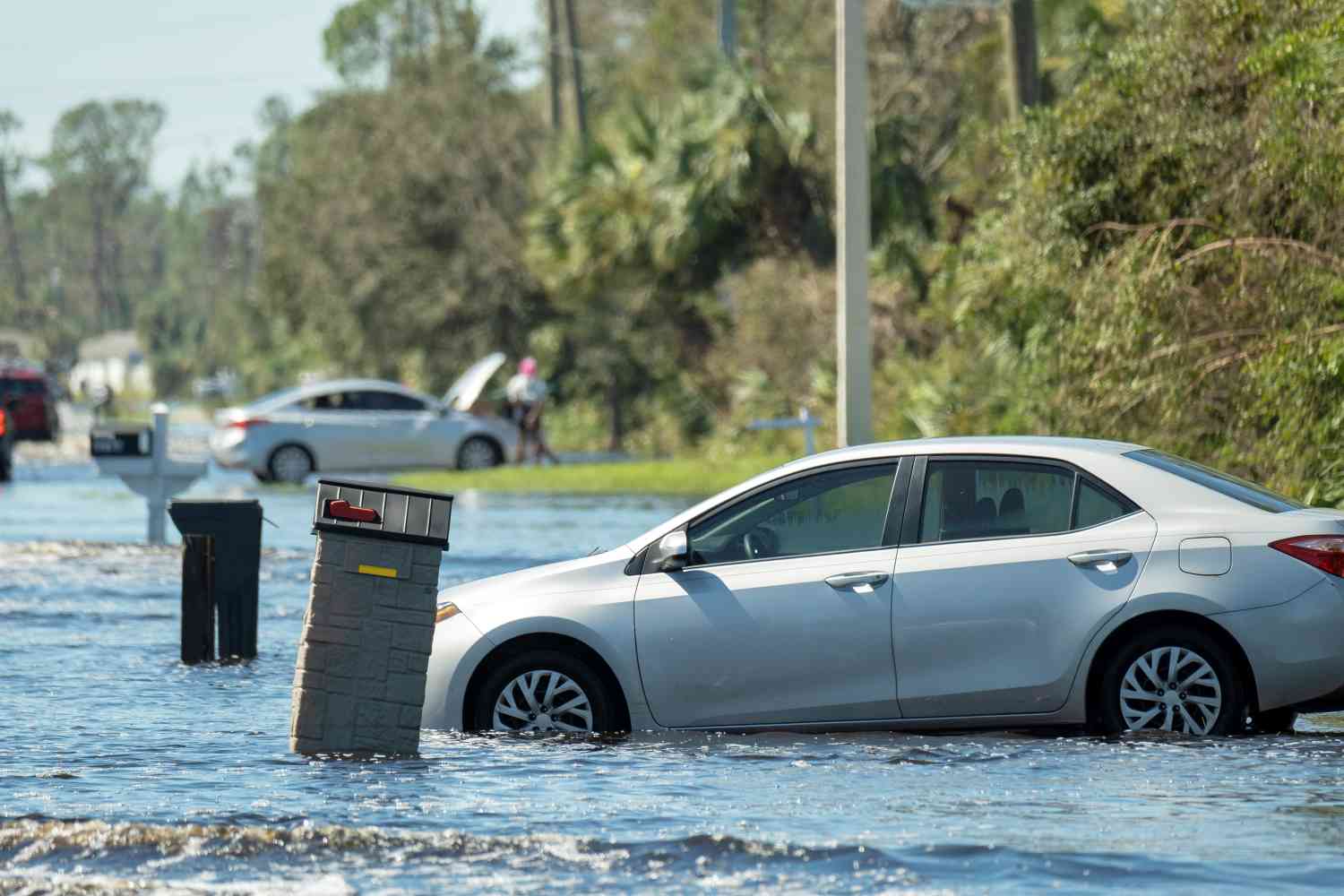9000+ Cashless Garages
96% Claims Settled (FY 24-25)

9000+ Cashless Garages
96% Claims Settled (FY 24-25)



Vehicles are more likely to be damaged in areas prone to heavy rainfall and sudden flooding. Water entering your car can cause extensive damage to the engine and electrical systems. This may result in substantial repair bills and safety concerns.
Hence, being well-prepared and claiming insurance for your car during a disaster is a great way to manage the damage caused. This article will explain what to do if your car gets flooded, how to stay well-prepared, and how to file an insurance claim accordingly. Read on to learn more.


A flooded car is prone to numerous mechanical and electrical issues. The water can seep into narrow car pipes and cause internal damage, in addition to the exterior damage it is already causing. Here are a few common problems arising from car flooding:
As water enters seats, rugs, and interior panels, it almost constantly carries contaminants, which may result in unsightly stains in hidden spaces that are difficult to eradicate.
Hydrolock is the cause of catastrophic damage to engine components, essentially when water is introduced into the power plant along with air. This results in severe damage to items such as pistons and connecting rods.
It can affect the electrical wiring throughout the vehicle because rain or flood water corrodes or short-circuits it. When short-circuited, problems usually include malfunctioning.
Extensive repairs may be needed after flooding with water, as the vehicle's electrical system can experience a complete malfunction, starting with the sensors and controllers.
When facilitated entry into the fluids, such as brake or gearbox fluids, occurs, these fluids lose their effectiveness. This matter could pose a safety threat while driving and lead to long-term mechanical damage.
A flooded car can be complicated to handle. Specific steps must be taken to prevent further significant damage to the vehicle. Here are the immediate steps to be followed after your car is flooded:
Cars should not be started immediately after being submerged in floodwater or going through flooded areas, as water quickly enters the engine's cylinders, causing hydrolocking.
Disconnect the vehicle's battery to prevent an electrical short circuit. Exposure to floodwaters may damage the wiring and electrical components of the car, potentially resulting in permanent damage if the power is still on.
Look for water contamination on the dipstick, indicated by a milky appearance. Additionally, check the air filter for moisture. In the case of water, an engineer should replace these components.
Remove all water-soaked carpets, mats, and seat covers to prevent mould and mildew from forming. Dry the interior using towels and fans, being careful to inspect hidden areas where dampness may still be present.
Inspect all fluids in the vehicle, including brake fluid, transmission fluid, and coolant, for any water that may have contaminated them during the flood. The contaminated fluids should be drained and replaced.
Check the undercarriage, exhaust system, engine compartment, and the rest of the engine. Then, wash and dispose of it accordingly if debris accumulates, such as dirt or silt.
If you're unsure about the level of damage, it's best to call a reliable mechanic and bring the car to their premises. It is essential to check the engine and electrical systems for any possible damage.
Performing a little salvage on a flood-damaged car requires plenty of attention and quick action to keep costs down and restore it to usability. Here's a breakdown of the repair procedure:
First, inspect the flooding levels to see if the water has reached the car's engine, electrical components, and interior. This way, you can establish whether the damage is repairable or not.
Disconnect the car battery immediately to prevent short-circuiting while addressing electrical issues. The floodwaters will damage the wiring and electronics of a different vehicle through water.
Flush all necessary fluids from the engine oil, transmission fluid, and brake fluid systems. If not changed, these fluids will become contaminated with water and ultimately cause further damage.
Remove all water-soaked materials, including floorboards, seats, and upholstery. Set up fans and dehumidifiers to thoroughly dry the interior, paying special attention to hidden areas where moisture can accumulate.
After salvaging the car, schedule a professional inspection to assess the full extent of the damage. Have a certified mechanic inspect the car's critical components to assess any water damage.
Have the insurance company assess the damages to determine whether repairs are viable or a loss. Collaborate with them to determine if the car can be salvaged or is a total loss.
Ensure that all necessary repairs are done, including fluid replacement, cleaning, and mechanical fixes. Use high-quality parts to restore functionality and reliability, followed by a comprehensive test.
Conduct a final diagnostic check to ensure the car is safe and fully operational after repairs. Test the car on the road and inspect for any remaining issues before returning the vehicle to use.
To file an insurance claim, it is essential to contact your insurance company immediately in the event of a car flood. Here is your step-by-step guide for claiming an insurance claim for a flood-damaged car:
The first and most crucial step is to inform your insurance provider of the flooding. Please inform them about the situation so that they can formulate the necessary legal documentation and understand its scope.
You need to have photographs of the damage to your car, which will serve as evidence when you present them. Take pictures from different angles and hand them to reinforce your claim.
Make a damage assessment to be lodged with your insurer. Such assessment must include details such as policy numbers, the name of your insurance company, and estimated damages.
The insurance company will send its surveyor to inspect the damaged car after the claim is filed. They will inspect the loss to ascertain the merits of the claim.
They process the evaluation and settle according to terms and conditions. With this, the insurance company has confirmed that your claim has been successful.
Water exposure in cars poses one major problem, which is mould growth. It can cause long-term damage to the vehicle and its interiors. Here are a few measures to be taken to prevent mould formation after flooding:
Before cleaning, the most crucial point is to reduce the humidity in the vehicle to prevent mould growth in humid conditions. Open all doors and windows to allow air to circulate and speed up the drying process with fans.
Vacuum the carpet, upholstery, and mats once the car has dried to remove all dirt and debris. This removes any dead mould spores. The places you can't see are the ones behind the seats, where mould may accumulate.
Vinegar is a natural disinfectant and mould killer, so it is well-suited for cleaning surfaces that are often affected by mould. This solution should treat upholstery, fabrics, and all areas that might be infected.
Spray the vinegar solution generously over all the mouldy spots and cover thoroughly. Allow the solution to slaughter all mould spores for several minutes. Wipe away any visible mould.
Flood waters could severely damage the working life of your vehicle. Preventive measures must be taken to prevent them from wet damage. Here are a few precautions that can be considered:
Always be aware of the forecast and avoid areas susceptible to flooding during heavy downpours. Planning your route and undertaking proper arrangements could reduce the chances of flood damage.
Whenever possible, park the vehicle in areas that are elevated and flood-resistant. This location will serve as a shield for your car, saving it. It is also essential to stay away from water when rain is a menace.
Ensure each window and every door is shut perfectly to reduce the possibility of moisture entering the car's cabin. Check and service your vehicle's weather seals to keep them in good order.
These items include additional protective features, such as flood mats or water-resistant covers, which provide an extra shield against flooding. This will minimise the threat of immense damage to the vehicle during flood times.
Ensure that your loyalty to your insurance company provides you with comprehensive car insurance coverage, including flood protection. Always try to have full-coverage insurance, as that provides complete security in any unintended situation.